JOHN S. MASON - CONSERVATION
OF WALES' MINERAL HERITAGE:
THE OLD METAL MINES OF WALES
Note:
to return to the Conservation page of John Mason's main site, please
click on EXIT
at the bottom of any of these pages.
Wales
has over 1000
workings wrought in search of metals. Some just consist of a tunnel
driven 5 paces and abandoned. But others were major producers. Mining,
since Bronze Age times, has produced copper, lead, silver, gold, zinc,
iron, manganese, antimony, arsenic and barite. The mines therefore
constitute an important scientific resource for the study of the
mineralisation that they worked. Many are also of great archaeological
importance, although one can have archaeologically-important but
mineralogically-disappointing sites - and vice-versa.
Mines represent a particularly threatened group of sites. They often
end up as unofficial rubbish-dumps. Sometimes, it is necessary to take
action to prevent the spread of harmful pollutants and this can
threaten areas of mineralogical interest. Spoil may be taken for
hardcore or the tips may become completely overgrown. Minescan ensured
that a representative selection will not share this fate! Here are some
examples:
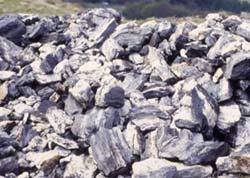 |
This is
part of a spoil-heap at
Cefn Coch gold mine near Dolgellau. The mine is on National Trust land
and the buildings have been carefully looked after. The site has been a
SSSI for some years.
It is a great site for the study of the Gold-belt lode textures. This
tip is composed of lode fragments consisting of white quartz and black
Clogau Shale. |
 |
This is
a polished slab cut from
a block of lode material from the tip above. The field of view is about
20cm high. The lodes typically have the ribboned appearance as seen
here, a feature which indicates repeated fracture reopening and vein
mineralisation. |
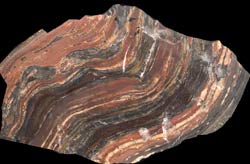 |
Close
to the Dolgellau
Gold-belt, there outcrops a bed of sedimentary manganese-ore which has
been worked extensively around the flanks of the Rhinogau. There are a
plethora of sites at which the geology and mineralogy are visible, but
those high in the northern Rhinogau are particularly spectacular,
combining geology, archaeology and stunning mountain scenery. This cut
and polished sample shows the layered appearance of the very
fine-grained ore, which consists chiefly of manganese-bearing
carbonates and silicates. The various pinks and yellows are typical of
the unweathered ore: at some sites it has weathered to a
chocolate-brown colour. |
 |
This is
a view of the eastern
section of Darren mine in Central Wales. Darren was, with other nearby
mines, a celebrated 16th-17th century silver producer. The silver
grades of the ores were much higher in these mines than at most other
Central Wales localities.
The lower tip is derived from a shaft (Francis' Shaft) and a level
(Level Y Coed) driven into the hillside. The upper tips are from the
great opencast which crosses the hill, and which is another potential
Bronze Age working. An Iron Age hill-fort sits on the hilltop and
blocks of lode material have been found built into its walls during
archaeological excavations.
An excellent historical account of these mines has been written:
Hughes, S.J.S. (1990) The Darren Mines. British Mining No. 40. Northern
Mine Research Society, 131-141. |
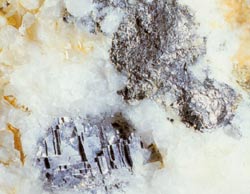 |
The
mineral responsible for the
high silver grades at Darren mine was discovered (or should I say
rediscovered after 300 years?) in the mid-1980s when I was doing the
research for my M.Phil. In this image, the grey, grainy-looking mineral
above the blue-grey galena is the copper-silver-antimony sulphide,
tetrahedrite. The aggregate is about 3cm across: they range from this
size down to a few tens of microns. The occurrence of this important
ore of silver, combined with the site's historical importance, make the
Darren mine a prime candidate for preservation. |
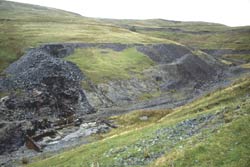 |
In the
wilds of Plynlimon, close
to the source of the River Wye (Afon Gwy), lies the Nantiago mine. Due
to its remote situation and a careful landowner, the mine has not
suffered the damage that has occurred at some others. It is also of
importance as the best locality to study the Central Wales A2-c
assemblage (calcite-sphalerite-galena; open fissure-filling). It is
part of a much larger SSSI and permission to visit must be obtained
from the landowner and from the Countryside Council for Wales. |
 |
Another
remote site, Ceulan Mine
in NW Powys, reveals an excellent lode outcrop with much sulphide
(galena has weathered grey-white in the image). |
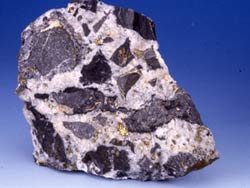 |
The
study of mineralisation
involves a number of techniques. Hand-specimens may reveal much of
interest to the naked eye: in this block of quartz-cemented breccia
from Brynyrafr mine, metallic gold-coloured spots of chalcopyrite are
visible. |
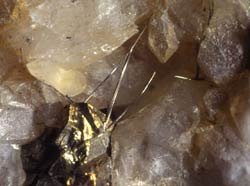 |
Under
the binocular microscope,
another sample from Brynyrafr mine shows metallic needles associated
with the chalcopyrite. These are the nickel sulphide, millerite, a
widespread mineral in Central Wales in small amounts. |
 |
To
study ore minerals at higher
magnification, small fragments are mounted in epoxy resin and ground
flat then polished to an optical mirror-finish. It is then possible to
see mineral grains only a few microns across. The prepared samples are
studied using a petrological microscope using reflected light. Here, in
a sample from Esgairfraith mine, millerite (bright yellow) forms veins
in the cobalt-nickel sulphide siegenite (pinkish-grey), the whole lot
overgrown by yellow chalcopyrite. For more of these mineral images go
to my Central Wales page via the Mineralogy page! |
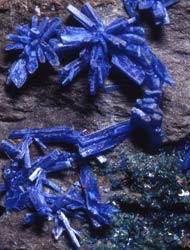 |
Wales
also boasts a large number
of secondary minerals, formed by the weathering of the primary
sulphides by oxidising groundwaters. Some were formed long ago in situ
underground, while others have formed within the mine-tips since mining
ceased. The latter group include some very colourful species like the
dark blue lead-copper sulphate linarite (left). The crystals are 1-2mm
long so again the best study method is a binocular microscope. |
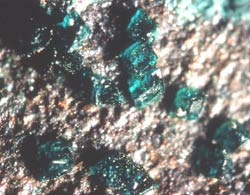 |
This is
one of Wales' rarities -
bottle-green crystals of the copper-zinc sulphate mineral ramsbeckite.
The mineral was only discovered and named in 1987, from a locality in
Germany. This sample was found at Penrhiw Mine in Central Wales in 1992
and the crystals are up to 1mm across. Some mines are under protection
because of their rare secondary mineral assemblages. Understanding the
chemical processes leading to their formation is of considerable
interest as they act as reservoirs for otherwise mobile heavy metals
which cause environmental damage. |
ROAD
CUTTINGS AND
QUARRIES
NATURAL
EXPOSURES
EXIT
|











